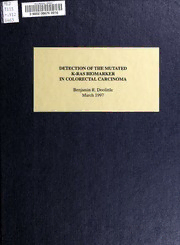
Detection of the mutated K-Ras biomarker in colorectal carcinoma PDF
Preview Detection of the mutated K-Ras biomarker in colorectal carcinoma
YALE UNIVERSITY CUSHING/WHITNEY MEDICAL LIBRARY Permission to photocopy or microfilm processing of this thesis for the purpose of individual scholarly consultation or reference is hereby granted by the author. This permission is not to be interpreted as affecting publication of this work or otherwise placing it in the public domain, and the author reserves all rights of ownership guaranteed under common law protection of unpublished manuscripts._ Date Detection of the Mutated K-Ras Biomarker in Colorectal Carcinoma A Thesis Submitted to the Yale University School of Medicine in Partial Fulfillment of the Requirements for the Degree of Doctor of Medicine Benjamin R. Doolittle March 1997 T U2) VA1F Mrninai UBRARY i . Viz AUG 0 4 (997 G ^03 DETECTION OF THE MUTATED K-RAS BIOMARKER IN COLORECTAL CARCINOMA, Benjamin R. Doolittle, Janet Emanuel, Jose Costa, Department of Pathology, Yale University, School of Medicine, New Haven, CT. This study describes an advantageous, effective protocol for detecting k-ras mutations in human stool as a prototype screen for colorectal carcinoma (CRC), the third most common malignancy in the United States. A reliable screening test that detects early lesions would contribute to a decrease in mortality. Currently, the only non- invasive screen for CRC is the heme-occult test which has a high false-positive rate. Previously, several investigators have identified genetic biomarkers for CRC in stool DNA. The k-ras oncogene, mutated in 46-50% of CRC tumors, serves as one molecular marker by which stool samples may be evaluated for early detection of adenocarcinomas. DNA was isolated from stool samples by a new method we specifically designed for extracting high quality DNA using tetradecyltrimethylammonium oxalate (Catrimox-14). This protocol produces an optimal yield of high purity DNA, suitable for genotyping. Detection of the human gene in stool samples was enhanced by hybrid selection of the k-ras sequences. Polymerase Chain Reaction (PCR) and single-strand conformation polymorphism (SSCP analysis). Tumor tissue and pre-operative stool samples for eight patients were k-ras genotyped and compared; stool samples from two asymptomatic, healthy patients were also evaluated in a double blind format. In seven of eight samples (87%), the genotype of the stool and colon tissue DNA was the same. Both healthy patients showed wild-type k-ras. This protocol shows promise for the development of an efficient and accurate screen for CRC. Digitized by the Internet Archive in 2017 with funding from Arcadia Fund https://archive.org/details/detectionofmutatOOdool Acknowledgments: For the guidance, friendship, trust and encouragement, I am indebted to Janet Emanuel who set me to soar in this project. For Jose Costa, I am grateful for the vision and enthusiasm he inspires. For Debbie Dillon, Veronica Dombi, and Lola Bautista, I am forever in their service. For Christine Damico, I am thankful for her preparation of the tumor DNA samples, and initial work on the gene enrichment procedure. Without their help, always offered in friendship, this work would not have been possible. For Tanya, the joy of my life, 1 am ever so deeply thankful for her loving support. Table of Contents Introduction. 5 Statement of Purpose ...9 Materials and Methods.11 Samples.1 1 DNA Extraction. 13 DNA Quantitation. 16 Enrichment of k-ras.17 Polymerase Chain Reaction.18 Single Strand Conformational Polymorphism. 19 Results. 2 0 DNA Extraction and Quantitation.2 0 k-ras Enrichment and Polymerase Chain Reaction.2 3 Single Strand Conformational Polymorphism. 2 3 Discussion. 2 7 DNA Quantitation. 2 7 Character of DNA. 2 9 Further Evaluation.3 0 Role of Screening Test in Patient Care. 3 2 Literature Cited. 4 0 Tables and Figures Table 1. Literature Summary of Stool Biomarkers.10 Table 2. Protocol of Detection of k-ras Biomarkers.. . 12 Table 3. Catrimox Extraction Protocol.15 Table 4. DNA Quantitation By CytoFluor and Optical Density ... 2 2 Table 5. Genotype of Stool and Tissue DNA. 2 6 Figure 1. Comparison of DNA Yield.3 4 Figure 2. Catrimox-14 Extraction of Stool DNA. 3 5 Figure 3. Catrimox-14 Extraction of Clinical Stool DNA.3 6 Figure 4. Comparison of Catrimox and Organic Extraction.3 7 Figure 5. SSCP of Stool Samples... 3 8 Figure 6. SSCP of Colon Samples.. 39
